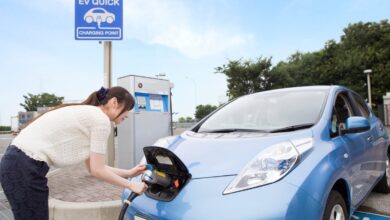Are Electric Vehicles Really More Dangerous To Pedestrians?

One of the many criticisms of EVs is that they are too quiet, so pedestrians won’t hear them coming when they cross the road. There is particular concern about what this might mean for blind people, despite there being scant evidence that this is really a problem. In the last few days, however, news publications have found an academic study that they think proves that EVs are a LOT more dangerous to pedestrians. The problem is that there are questions to be asked about the study’s science and how uncritically these newspapers have accepted the findings.
Are EVs more likely to cause accidents with pedestrians, and is it because they are quieter?
The British publications I came across covering this story were The Guardian, the Express and Sky, as “Electric cars more likely to hit pedestrians than petrol vehicles, study finds”, “Electric cars more likely to hit a pedestrian than petrol vehicles” and “Electric vehicles more likely to hit pedestrians than petrol cars – study”, respectively. It has also been picked up by the Los Angeles Times as “EVs and hybrids are twice as likely to hit pedestrians as gas cars, study shows”. All these articles are based on a research article from Journal of Epidemiology & Community Health. As you can see from the headlines, they assume the findings of the study are correct, and it’s likely that the Express, LA Times, and Sky pieces were “inspired” by the Guardian one. None of them digs deep enough into the data, which is surprising when The Guardian’s writer is a science editor with a research background.
Old Data From Before 2017
First, the claims. The study concludes that EVs (including hybrids and full electric, which the study groups together with the term “E-HE”) are three times as likely to cause harm to pedestrians than internal combustion engine (ICE) vehicles in urban areas, although there was no difference in rural areas. This was based on UK data of 96,285 pedestrians being hit by a car or taxi during the period of study, of which 1,652 were marked as being vehicles classified as E-HE.
But there are some problems with this conclusion. The first is the age of the data in question, which ranges from 2013 to 2017. Anyone who follows the EV market will tell you that a lot has happened since 2017 with EVs. In fact, there were barely any all-electric cars (BEVs) in the UK during that period. In September 2017, there were 38 million vehicles on British roads, but only 130,000 of those were plug-in hybrids or BEVs. In 2013, just 3,586 cars in this category were sold, and only 1,074 of those were BEVs. By 2017, the figures were 35,586 PHEVs and 13,597 BEVs. In contrast, 72,523 non-plug-in HEVs were sold in 2017. In other words, the vast majority of E-HE vehicles in the 2013-17 period of study would have been hybrids and plug-in hybrids, not BEVs. Yet the news articles based on this study talk about electric cars and electric vehicles, with a clear implication that it’s BEVs being talked about – when clearly it isn’t.
The British study will have been based mostly on hybrids, because barely any BEVs had been sold by … [+]
Then there are the figures provided for travel miles used to calculate the number of casualties per 100,000 miles of journey. The study says this was performed by multiplying the average annual mileage by the number of vehicle registrations of each fuel type, estimated separately for urban and rural environments. This is where things get very curious. The study says it has come up with figures of 32,000 million miles of travel for E-HE cars and 3,000,000 million miles for ICE vehicles. However, these figures are based on the UK Department of Transport’s National Travel Survey (NTS), which shows an average annual travel figure of about 7,000 miles per car during the 2013-17 period.
Presumably (this isn’t stated clearly), the study is using a five-year timeframe, so that’s 35,000 miles of travel per vehicle over the five years. But if you divide that into 3,000,000 million miles you get 85.7 million vehicles, which is clearly wrong – it’s more than twice the number of vehicles on UK roads. For E-HE vehicles you get 914,000 vehicles, which is even more wildly divergent from the true figure. The study had data “under special license” from the NTS datasets, so it isn’t clear how these mileage figures were calculated, but the results seem wrong. This is a major omission for a scientific paper, which needs to be very clear about how its figures are derived. It throws doubt on the rest of the conclusions.
Nicolas Cage And Swimming Pools
Whether or not the study’s proposed correlation between E-HEs and pedestrian casualties is numerically correct, or at least relative to ICE, there is a very old adage in data science that “correlation is not causation”. Famously, there is a correlation between the number of people who drowned after falling into a swimming pool in the US and the number of number of films Nicolas Cage starred in during that year. It’s patently ridiculous to conclude that Nicolas Cage films are dangerous, and there could be other factors at play with the E-HE statistics too. For example, hybrids have been popular with private taxi drivers due to their economic fuel consumption, and private taxi drivers are not exactly renowned for their driving safety. The disparity between urban and rural figures cited in the study might back this up.
The fact Nicolas Cage films correlates with pool drownings does not make him a dangerous actor.
The study itself also claims that E-HE vehicles are bought by young people, arguing that young people drive less safely than older people. This is a bit laughable when you look at the current BEV market, where the price (and insurance costs) of BEVs make them harder for young people to afford. The figures the study uses to back up its argument about young EV buyers are also from 2023, not from 2013-17 like the rest of the main statistics, so they are conflating two very different time periods. The EV market has changed unrecognizably since then, with very different motivations.
The study’s main conclusion is that mitigation is required to make EVs safe, but that has already happened. From 1 July 2019, all EVs in Europe had to include a system to emit sound below 12.4mph. Japan issued similar guidelines as far back as 2010, and a US ruling for cars travelling below 18.6mph came into force in September 2020. The noise level for the Acoustic Vehicle Alerting System (AVAS) deployed to make sound must be at least 56dBA within 2 meters. Some of the news articles based on this study do mention this, and the study’s main author has said he plans to conduct a new study based on newer, post-AVAS data. However, the original study should have considered that none of the vehicles it is based on had AVAS, and now most new EVs do. So the conclusions are out of date.
It should also be noted that modern Advanced Driver-Assistance Systems (ADAS) now often include pedestrian detection and avoidance, which will reduce the number of collisions of this type irrespective of vehicle type. Also, while EVs are quiet without AVAS, they’re not silent. They make just as much, if not more tire noise (due to extra weight). I’ve owned some pretty quiet ICE cars, which had engines so silent at 20mph there’s barely any difference to a BEV. If you’re expecting to hear an ICE, you might not be listening out for tire rolling noise. Or you might have your nose buried in your smartphone and not paying attention at all.
We Need Better EV Journalism
We all want safer roads, but it’s hard not to think that this study and the news articles based on it are jumping on a bandwagon of antipathy against electric vehicles and change in general. There are rumors that some journalists really have been told to find anti-EV stories by their editors, because they reckon it’s a traffic winner. It would be a surprise if The Guardian was one of these, however, considering its generally positive stance towards environmentalism.
Modern EVs are packed with safety technology, including sound emitters that operate at low speed.
The moral of this story is that journalists really shouldn’t just repeat findings from supposedly scientific studies without checking the data. As an academic myself who has published a few journal papers, I know the process involved. There is supposed to be peer review, which does go some way towards catching suspect research. But it’s far from being foolproof, and in the case of this study, it appears to be Master’s degree work that was then published by the supervisor (under his name) in a journal published by his own institution. I wonder what the peer review process was, and if anyone who knows about BEV technology was involved. They might have spotted the issues with the mileage calculations and just how irrelevant data from 2017 and earlier is when the electric car market is moving so fast.
There’s certainly something that warrants further investigation and clarification with the Journal of Epidemiology & Community Health study. But the journalists who have regurgitated its findings with barely any critical analysis need to take a good hard look at their own professional abilities. Either they had an anti-EV agenda and were deliberately repeating a story that confirmed their bias, or there were some obvious questions to be asked, and they didn’t ask them. They took the findings for granted when journalists are supposed to dig deeper.



